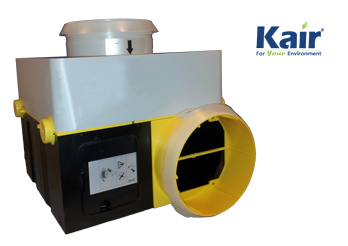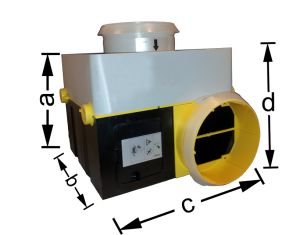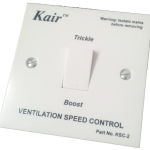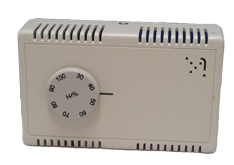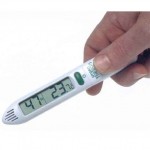(Discontinued) Kair Whole House Input Ventilator K-WH150
Provides Continuous Background Trickle Ventilation In Houses And Bungalows
Product Features
- Meets Building Regulations requirements Document F1 (Alternative methods)
- Easy to install (no external access required)
- Whisper quiet
- Continuous Running trickle or boost ventilation
- Humidity sensor (optional)
- Low running costs
- Positive input airflow
- Security ventilation™ (no need to open windows)
- Health benefit – produces dramatic improvements of indoor air quality
- Heat energy dividend (solar gain)
General Product Information
Kair™ Whole House Input Ventilators (Loft units) have been designed to create a continuous input of air (providing a capacity to move a maximum of 375m 3 per hour). This will effectively combat condensation dampness and mould growth and meets or contributes towards the F1 Building Regulation requirements for ventilation. Kair™ Loft units create a continuous drying out process in dwellings and will help provide protection for hygroscopic material such as books, leather goods, wooden furniture, clothing and other fabrics from mould.
Energy Efficiency
Unlike conventional extractor fans, which suck out and waste expensively produced heat, the Kair™ Loft Input Ventilator utilises heat that exists in lofts through solar gain and simultaneously circulates existing heated air that has raised to ceiling height, heat which also helps increase temperature of the loft space air supply to the unit.
The continuous air movement throughout the property creates surface evaporation of moisture contained in the building fabric. This in turn, creates a drying out process, which means that there will be less hidden moisture to heat up increasing efficiency savings.
Kair™ Loft Input Ventilators consume less than a 60 Watt light bulb when in boost mode and less than a 40 Watt bulb when on background trickle.
Health Dividend
As long ago as 1989, an article in the British Medical Journal referred to the health hazards associated with condensation and mould growth in dwellings. The Statutory Fitness Standard clearly states that dwellings with inadequate ventilation, condensation and mould growth problems are unfit for human habitation and Building Regulation Guidelines require a supply of fresh air and the removal of pollutants.
Kair™ units, by reducing humidity to optimum levels (Kair Health Line™), eradicate condensation, prohibit mould growth and discourage the spread of bacteria, viruses and dust mite activity. By expelling dust particles, gasses and other household pollutants, the units create a dramatic improvement in the quality of the indoor air supply.
How It Works
Condensation occurs when the water content of air rises above a level called the ‘dew point’. At such time, water droplets will form on the coldest surfaces e.g. windows, external walls etc.
On average, a family of four people will produce about two gallons of water vapour per day from activities such as cooking, bathing, breathing and the washing and drying of clothes.
It is also a fact that nowadays most properties are insulated to prevent warm air from escaping. This reduction in ventilation allows the air contained within the property to reach a higher relative humidity.
 Kair™ Loft units sited in the roof void draw in fresh air from the eaves. The air is warmed by Solar Gain in the loft space and is filtered and passed through ducting to discharge at landing ceiling level. The fresh air mixes with warm air rising up the stairwell and redistributes it throughout the entire property.
Kair™ Loft units sited in the roof void draw in fresh air from the eaves. The air is warmed by Solar Gain in the loft space and is filtered and passed through ducting to discharge at landing ceiling level. The fresh air mixes with warm air rising up the stairwell and redistributes it throughout the entire property.
Each room is slightly pressurised and the continual air movement eliminates any stagnant pockets of moisture-laden air, which is eventually expelled through natural leakage points (window and door crevices, flues, air grilles etc.). In effect reversing the tendancy towards cold draughts entering the property.
An overall improvement in the internal atmosphere will be noticed within a few days.
Control
To combat the variable factors related to humidity levels, the Kair Loft unit has a specially designed speed control, which allows the user to adjust the airflow rate as and when it is felt necessary.
Installation Instructions
Any competent D.I.Y. enthusiast or an electrician can simply install the Kair Unit. Easy to install, out of site in the loft space, the unit has an Input Diffuser, usually fitted over the stairwell, which creates a vortex of warm air, which is then pushed around the dwelling by the input ventilator. This recycled heat, which would normally disappear into the loft, is used to temper the incoming fresh air.
Product Specifications
Please see separate specification clause leaflet.
Product Maintenance
No maintenance is required, only a change or clean of air filters every year or two dependant on prevailing conditions.

Electrical Safety
Installation can be carried out by a suitably qualified craftsman and connected to electrical supply by an electrician in accordance with IEE Regulations.
Regulations
The unit meets Building Regulations.
Product Dimensions
| Dimensions (mm) | |||
| a | b | c | dØ |
| 220 | 275 | 275 | 150 |
Performance Specifications
| Trickle | Boost | |
| Airflow | 150m³/h | 375m³/h |
| Watts | 30 | 55 |
| dBA | 21 | 45 |
| Voltage | 230V | |
| Weight | 5Kg | |
| Casing material | Grade 1 fire retardant white PVC | |
WHY SPECIFY Kair™
Ventilation is necessary to maintain a healthy and comfortable internal environment and to rapidly remove pollutants such as moisture, volatile organic compounds (VOC’s), allergens such as dust, oxides of nitrogen, carbon monoxide, carbon dioxide, tobacco smoke and unpleasant odours.
Moisture is generally assumed to be the most significant of these pollutants because of the high rates of generation from cooking, bathing, washing, drying etc and the consequential condensation and mould growth problems. It follows that if the ventilation strategy is based on controlling this principle pollutant by input ventilation then logically the other indoor pollutants will also be adequately controlled.
Stale air, and air which is hot or humid, should be replaced at a reasonable rate.
Good ventilation means providing a balance between energy efficient and healthy indoor air best summed up by the catchphrase ‘build tight – ventilate right’.
The fresh air supply rate should not normally fall below 5 to 8 l/s per occupant. This is best achieved by creating continuous air changes of 0.5 to 1.0 every hour, throughout the entire dwelling as specified in D.E.T.R. Good Practice Note 268.
Although building regulations relate to new buildings the guidance on ventilation is applicable to existing dwellings and, most important of all, the regulations are concerned with minimising the risk to health from the build up of pollutants. The KWH150 satisfies all of these criteria.
Available Accessories
References
- i. Statutory Fitness Standards – Housing Act 1985
- ii. Department Of The Environment F1 Guidance – Means Of Ventilation
- iii. Airborne Fungal Glossary – Basic Fact About Mould –TRD
- iv. Housing Act – (COSHH) Control Of Substances Hazardous To Health Regulations – 1988
- v. Optimum Relative Humidity Guide KTIC
- vi. Building Research Establishment. Digest 297 ‘Surface Condensation And Mould Growth In Dwellings’
- vii. NHS – A Health Strategy For London
- viii. DETR – Energy Efficient Ventilation In Housing – Good Practice Guide 268 ix. Home Energy Conservation Act 1985 x. British Standards Institution. Bs 5250. ‘Control Of Condensation In Buildings’. BSI, London, 1989
- xi. Perera M D A E S And Parkins L M. ‘Build Tight – Ventilate Right’. Building Services Journal, June 1992. – CIBSE, London, 1992 xii. Property Associated Technical Standards

